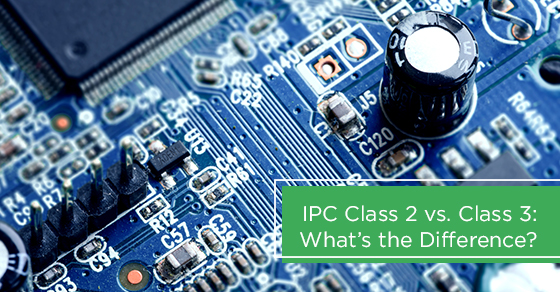IPC Class 2 vs. Class 3: What’s the Difference?
IPC separates PCBs into three classes for electronics manufacturing, indicating a PCB's quality.
PCBs of the lowest grade are included in Class 1, while those of the highest quality are in Class 3. It is important to note the class of a PCB that is being used in an electronic device, as a PCB's class is connected to its safety and performance specifications. A particular class of PCB may be necessary for a product to pass inspections and meet specific quality standards.
In most cases, you can use Class 1 PCBs in everyday products and consumer electronics with a simple function and a limited life in which the primary requirement is the function of the completed IPC assembly.
You can use Class 2 PCBs in dedicated services electronic products, like microwaves, laptops, and televisions, for which an extended lifespan is necessary.
Class 3 PCBs are used in high-performance products, such as advanced medical equipment, clean technology, and machine learning, where product downtime is not possible, and the end-use environment is exceptionally harsh.
What are the main differences between IPC Class 2 and Class 3?
Just as there is a significant difference in quality and applications between Class 1 and Class 2 PCBs, there is a similar difference between Class 2 and Class 3. The following descriptions are the best way to describe how these two PCB classes are unique:
Class 2 PCBs
Compared to Class 1, Class 2 PCBs exhibit higher characteristics, have an extended lifespan and are deemed more reliable. This extended lifespan and improved reliability are possible since Class 2 PCBs are subjected to strict standards as they are manufactured to only allow for some cosmetic imperfections.
With Class 2 boards, uninterrupted service is not essential. However, it is generally preferred, as the board may run continuously, but its operation is not overly critical.
Class 3 PCBs
Class 3 PCBs must be able to maintain a higher calibre of performance on demand and at all times.
Even higher levels of inspection with even more stringent standards are performed during the manufacturing process, which makes them even more reliable than Class 2 PCBs; however, it also increases the inspection time and is consequently more expensive.
This testing includes steps to ensure these PCBs can withstand the harsh environments they may experience depending on their application.
Some significant differences between Class 2 and Class 3 PCBs mainly relate to component placement for surface-mount components, cleanliness requirements based on residual assembly contaminants, and plating thickness in through-hole and on the PCB's surface.
For instance, surface-mount components may get placed slightly off the pad during the assembly process. Since this creates a visual defect but does not usually affect the electrical and mechanical performance of the PCB, it is not a problem in Class 2 PCBs.
On the other hand, such an imperfection is deemed unacceptable in Class 3 PCBs. If surface-mount components are off the pad in a Class 3 PCB, it will fail its inspection.
Another main difference between Class 2 and Class 3 PCBs is the barrel fill required for through-hole leads. Class 2 PCBs only need 50%, whereas Class 3 PCBs require 75%. In most cases, Class 3 items are marginally astringent, especially for copper voids.
There are situations when no copper plating is present in the opening's barrel, leaving the penetrated holes' dielectric material uncovered. On the other hand, Class 2 items allow up to five percent critical opportunity of a solitary void in the PCB's holes. In terms of plating thickness requirements, Class 2 requires 0.8 mils, and Class 3 requires 1 mil.
One more significant difference that separates Class 2 from Class 3 relates to drilling breakouts. If a PCB is in Class 2, it is permitted to have breakouts from the annular rings. A 90° break is okay if you keep up insignificant dividing into the sidelong sides.
In contrast, Class 3 PCBs do not permit cracked annular rings because they must be incredibly tough.
Why Circuits Central is the Best Place for PCB Assembly
Whether you require Class 2 or Class 3 PCBs for your electronic devices, you can count on Circuits Central for all your needs related to circuit development in Toronto. Our team of seasoned experts specializes in electronics manufacturing and PCB assembly.
We can provide you with a flexible-by-design and reliable production facility, making a range of production volumes and complexities possible. Through our high-quality PCB assembly services, we can handle everything from material management to PCB assembly to cable assembly to product testing to integration.
One of the essential parts of electronic product development is the design of the PCB layout, and during this process, we offer an unprecedented level of detail for each phase of the design. Our engineers will work with you to design the perfect PCB for your product based on your specific needs and requirements so that we can deliver a top-quality PCB that will exceed your expectations.
Once the ideal design has been established, we can move on to prototyping and small-batch manufacturing.
We fully understand that product inspections and quality requirements differ from industry to industry. Still, no matter what industry you operate in, our stringent and rigorous inspection and testing protocols will help ensure that your PCBs meet the industry's demands.
Our experienced staff members will help develop and implement testing procedures, including JTAG testing, in-circuit testing, environmental stress testing, single-sided flying probe testing, and double-sided flying probe testing, that are specific to your product's requirements to ensure quality assurance and control, reliability, and functionality before your product leaves our facility.
We use even more rigorous testing methods for Class 3 PCBs, as we know that their integrity is crucial.
For more information about our PCB design, assembly, and testing services or to learn more about our approach to Class 2 PCBs versus Class 3 PCBs, call Circuits Central at 1 (888) 602-7264 or email us at info@circuits-central.com.

